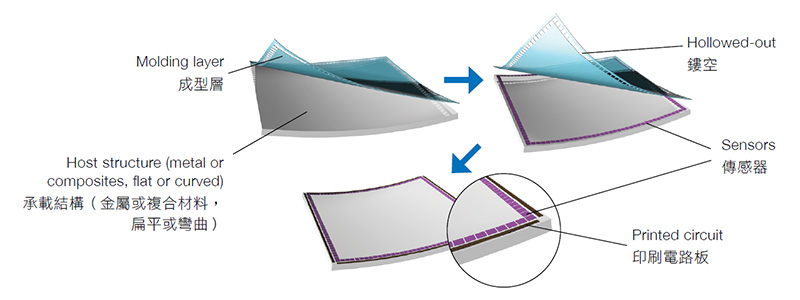
Prof. Su Zhongqing (second from right) and representatives of the team
A research team at the Department of Mechanical Engineering has developed a nanocomposite-inspired sensor that can be sprayed directly onto structures, creating sensor network to provide real-time information on structural health status.

Coating process for developing a sensor network
Led by Prof. Su Zhongqing and Prof. Zhou Limin, researchers at the Department of Mechanical Engineering have developed a novel breed of nanocomposites-inspired sensors which can be sprayed directly on flat or curved engineering structural surfaces. The sprayed sensors can be networked, real-time monitor the health condition of the structure on which they are fixed, showing any damage quickly and accurately. These sensors can faithfully perceive ultrasonic wave signals propagating in the structure. Any damage that interferes with the wave propagation, leading to unique scattering phenomena, will be captured by the sensor network. Based on wave scattering, the damage can be characterised quantitatively and accurately via an all-in-one system developed by the team. Due to its extremely light weight and low fabrication cost, a large quantity of this type of sensors can be deployed in a sensor network for detecting hidden flaws of structures, paving the way for a new era of ultrasonics-based structural health monitoring.
Each sensor is connected to a network via wires printed on the structure, which is structurally similar to the human nervous system. By analysing and comparing the electrical signals converted from the electric resistivity, the network can spot defects in a structure and translate the signals into 3D images.
The research team’s new nanocomposite-inspired sensors have many advantages over conventional sensors. The new sensor weighs only 0.04 grams, which means that more sensors can be attached to a single structure, collecting more information for analysis while adding less weight. It also has a wider frequency range of response, which is over 400 times greater than the highest frequency of available nanocomposite sensors.
“Due to its light weight and excellent flexibility to adapt to curved surface structures, the novel nanocomposite sensor can be applied to moving structures like trains and aeroplanes, enhancing the safety of engineering assets and revolutionising the traditional structure maintenance philosophy”, Prof. Su explained.
Another advantage of the new sensor is its cost effectiveness. It can be fabricated in large quantities to form a dense sensor network at a much lower cost. The innovative technique of spraying makes the sensor installation process much faster and more efficient than conventional means, and is applicable to various surface types.
This innovative new technology has been published in a number of top-tier international peer-reviewed journals, including Ultrasonics, Carbon, Smart Materials and Structures, and Composites Science and Technology. ♦
